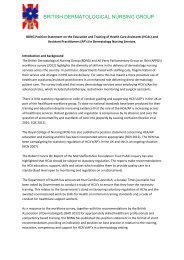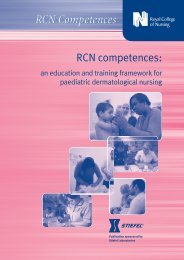Improving outcomes for people with skin tumours including melanoma
Improving outcomes for people with skin tumours including melanoma
Improving outcomes for people with skin tumours including melanoma
You also want an ePaper? Increase the reach of your titles
YUMPU automatically turns print PDFs into web optimized ePapers that Google loves.
<strong>Improving</strong> Outcomes <strong>for</strong><br />
People <strong>with</strong> Skin Tumours<br />
<strong>including</strong> Melanoma<br />
Organisation of <strong>skin</strong><br />
cancer services<br />
If two or more SSMDTs are established in one cancer network, there<br />
should be strong links between them. These SSMDTs should establish<br />
common clinical protocols across the network as a whole, and <strong>for</strong> the<br />
audit of all aspects of their work. Each team should appoint a lead<br />
clinician who will take an active role in the coordination of <strong>skin</strong><br />
cancer services provided by the network as a whole.<br />
If patients attend the SSMDT they should be seen in a combined or<br />
parallel clinic staffed by the core members of the SSMDT (see ‘The<br />
role of the SSMDT’). The history, histology and radiology of those<br />
patients who attend the SSMDT should also be presented at the<br />
review meeting.<br />
3<br />
Patients <strong>with</strong> lymphoma and other rare <strong>skin</strong> cancers (see chapter on<br />
‘Management of special groups’) should be dealt <strong>with</strong> by only one<br />
SSMDT in the network. All cases should be reviewed by the<br />
dermatopathologist designated by the network to have an interest in,<br />
and lead responsibility <strong>for</strong>, cutaneous lymphoma reporting. It is<br />
appropriate <strong>for</strong> the network lead dermatopathologist in lymphoma<br />
reporting to attend the clinics as necessary. The lead<br />
dermatopathologist in lymphoma reporting is likely to be, but is not<br />
necessarily, the SSMDT lead dermatopathologist.<br />
The NICE guidance on <strong>Improving</strong> <strong>outcomes</strong> in haematological<br />
cancers 25 permits considerable flexibility <strong>for</strong> the type and number of<br />
lymphoma/leukaemia MDTs. Multidisciplinary primary cutaneous<br />
lymphoma clinics have developed in several networks and have been<br />
highly successful. In particular this model facilitates patient<br />
examination and clinicopathological correlation, which is often<br />
essential <strong>for</strong> the accurate diagnosis of cutaneous lymphoma. These<br />
multidisciplinary clinics can be encouraged to continue and develop,<br />
depending on appropriate geography and case numbers. With<br />
appropriate core membership these could achieve MDT status, but<br />
should <strong>for</strong>mally feed back summaries to the SSMDT.<br />
The role of the SSMDT<br />
The SSMDT will also act as the LSMDT <strong>for</strong> their local catchment<br />
population. They should, in addition, review other specific groups of<br />
patients (Table 4); these will be referred in from other LSMDTs<br />
according to network protocols.<br />
25 National Institute <strong>for</strong> Clinical Excellence (2003) <strong>Improving</strong> <strong>outcomes</strong> in haematological<br />
cancers. London: National Institute <strong>for</strong> Clinical Excellence. Available from:<br />
www.nice.org.uk<br />
56<br />
National Institute <strong>for</strong> Health and Clinical Excellence















